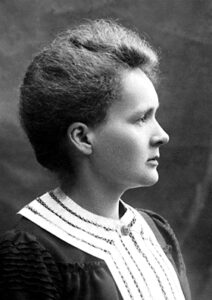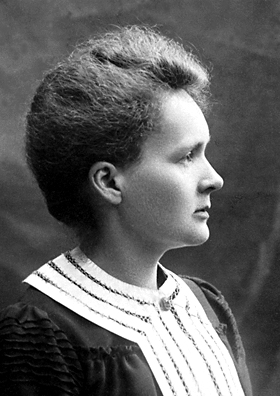Marie Curie is France’s most famous scientist and probably the most well-known female scientist in the world. Except she wasn’t French and Marie was not the name she given at her birth in 1867.
She was born Maria Sklodowska in Warsaw, now the capital of Poland, but Poland didn’t exist in 1867. The larger part of what is now Poland was occupied by the Russian Empire. Both Maria’s parents were teachers and came from the upper class in society although they had very little wealth. Many Polish men had been killed in uprisings against the Russians so women had taken over many jobs and the education of girls was seen as important as that of boys. Maria was the youngest of five children. Her parents brought her up to speak Polish as well as Russian and French, and also gave her a love of Polish poetry, literature and culture. This was dangerous as the Russians banned all forms of Polishness and insisted on Russian being spoken in public.

Soon after Maria was born, her mother began to suffer from TB (tuberculosis). She spent years with her oldest daughter, Zosia, in southern France where the warmth relieved the disease but she died when Maria was ten years old, two years after Zosia had died of typhus. The Sklodowski children were bright and eager to learn. Their goal was to study at university, but women were not allowed to attend universities in Poland and it was a struggle for the family to earn enough money to survive let alone travel. Maria came to an arrangement with her older sister Bronia who had a place to study medicine in Paris. Maria would work as a governess for a well-off family outside Warsaw until Bronia had qualified, then it would be her turn. Maria worked hard and also kept up her studies but she did find time to fall in love with the oldest son of the household. They planned to get married but the parents refused to allow it. Maria was very upset but kept working.
At last, in 1891 when Maria was 24 she was able to travel to Paris with the support of Bronia who had completed her studies and married. Very few students in Paris were women – just 23 out of 1800 at the Faculté de Science at the Sorbonne, part of the University of Paris, and most of the female students were, like Maria, from other countries. Maria had to work hard to improve her French and catch up in mathematics but she was an exceptional student. She did again find time to have a relationship with another student, a Monsieur Lamotte. In 1894, however, at the home of a physicist from Poland, she met a quiet man nine years older than herself. His name was Pierre Curie.
Pierre was head of the laboratory at the Paris School of Industrial Physics and Chemistry. He had previously worked with his brother Jacques on piezoelectricity. This is the property of some crystals that produce an electric current when squeezed. Now he was doing research for a doctorate on the effect of heat on the magnetism of materials. Maria was doing similar research as part of her studies. Pierre was only interested in his research and certainly not looking for a wife but he and Maria shared an interest in science and became close. When Pierre presented his thesis, Maria was in the audience. A few months later, in July 1895, they were married. In the summer of 1896 Maria completed her physics degree, top of the women’s list.
For Maria Sklodowska, now Marie Curie, her plans had changed. She had intended returning to Poland as a qualified teacher. Now she was a French wife and in September 1897 a mother of baby Irene, but she wasn’t going to give up on science. Pierre got permission for her to use a disused storeroom at his laboratory for her own research. Her topic was the mysterious rays given off by uranium discovered by Henri Becquerel in 1896. These rays were a minor curiosity while most physicists were focussed on Röntgen’s X-rays, discovered a year earlier.
Becquerel had observed that the uranium rays “electrified” the air. Marie set out to measure the effect. She was able to adapt apparatus that Pierre had devised in his piezoelectric experiments and it was very sensitive. Unfortunately, the room in which Marie worked was sometimes hot, sometimes cold and damp, all of which could have affected her results but she found a way round the problems. She started with the element uranium and its compounds as Becquerel had done. It was soon clear that the amount of radiation varied only with the amount of uranium in the sample. Marie rejected the idea that Becquerel had clung to, that the source of energy for the rays was sunlight absorbed by the uranium. She became convinced that it was a property of the uranium atoms themselves.
Marie moved on to test other elements and compounds. Most had no effect on her apparatus but one or two elements such as thorium and its compounds did. In fact, thorium proved to be more active than uranium. Then she started testing minerals which are mixtures of different compounds. Pitchblende is a mineral from which uranium is obtained. Marie was surprised to find that the mineral was much more active than either uranium or thorium. She reasoned that there must be something else in the pitchblende giving out the rays in addition to the uranium. It must be present in the pitchblende in tiny quantities not to have been noticed by chemists before and, as it would therefore be far more powerful than any other element Marie had tested, it must be a previously unknown element.
At this time, early in 1898, Pierre joined Marie in the research. They decided that they must try to separate the unknown element from the pitchblende. Marie was more experienced and interested in chemistry than Pierre so she took on the separation work while Pierre did the measurements on the samples. Their methods separated elements by their position in the Periodic Table. By June 1898 they had shown that there were two new elements, not one, in pitchblende. One was similar to bismuth (Bi, in group 5) and the other was similar to barium (Ba, in group 2). Marie and Pierre chose a name for the first element. They called it polonium (Po) after Marie’s currently non-existent homeland.
On 18th July 1898, Marie and Pierre’s report on their work was read out to the members of the French Academie de Sciences by Henri Becquerel. Marie couldn’t read it herself because she was not a member, being a woman and not yet having a Ph.D. Marie used a new word in the report, radio-active, to describe the property of the new element. That and the term radioactivity were quickly taken up by other scientists. Others were of course investigating this new area of science but Marie and Pierre were the only ones making precise and accurate measurements of radioactivity.
Now began the long process of extracting the new radioactive elements from the pitchblende. Where they had been using a few hundred grams of the stuff, now Marie was shifting tonnes of it. Polonium was separated but the second element, called radium, proved much more difficult. There was such a tiny amount of it in the raw material. It was another four years before Marie obtained a sample of a pure radium compound. During this time Marie and Pierre produced a stream of papers on radioactivity and radioactive materials. They were awarded prizes by the Academie of Sciences which were a great help to them as there was no university position for Marie and Pierre’s own post did not pay much. Their work was finally recognised in 1903 when they were jointly awarded the Nobel Prize for Physics for their discoveries in radioactivity. Marie was hailed as a heroine of France but she never lost her love for Poland.
Activities.
- Find out what happened during the rest of Marie Curie’s life.
- Maria’s school lessons in German Language were called Botany. Why was this?
- Why did Maria reach the age of 24 before she could attend university?
- Becquerel said the uranium rays “electrified” the air. We would say that the air was “ionised”. What does this mean?
- Why was it important for Marie to be able to measure accurately the amount of electrification or ionisation of the air caused by her different samples?
- How did Marie decide that pitchblende contained at least one previously unknown element?
- Why was the name, polonium, for the new element significant?
- Many scientists thought that only Pierre Curie should be awarded the 1903 Nobel Prize. What were the reasons for this?
- Marie Curie was the first, and until her daughter, Irene, won in 1935, the only female winner of a Nobel Prize. Why was this?
- Marie Curie deserved her fame because she founded a new science subject, radioactivity. Discuss this statement.
Bibliography
- Marie Curie, a life, by Susan Quin, pub. Mandarin 1995. An excellent complete biography
- Madame Curie, by Eve Curie pub. Heinemann 1938. A “heroic” biography by Marie’s second daughter.
- Marie & Pierre Curie, by John E Senior, pub. Sutton 1998. A brief biography and simple account of their work.
- Curie & Radioactivity, by Paul Strathern, pub. Arrow 1998. Part of the Big Idea series, a short and simple account of her life and work
Image Source
- Portrait of Maria Curie. http://www.nobelprize.org/nobel_prizes/physics/laureates/1903/marie-curie-bio.html
By Peter Ellis



